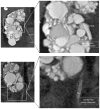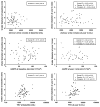Polyuria due to vasopressin V2 receptor antagonism is not associated with increased ureter diameter in ADPKD patients
- PMID: 27339446
- PMCID: PMC5497698
- DOI: 10.1007/s10157-016-1297-1
Polyuria due to vasopressin V2 receptor antagonism is not associated with increased ureter diameter in ADPKD patients
Abstract
Background: Tolvaptan, a vasopressin V2 receptor antagonist, has been shown to reduce the rates of growth in total kidney volume (TKV) and renal function loss in ADPKD patients, but also leads to polyuria because of its aquaretic effect. Prolonged polyuria can result in ureter dilatation with consequently renal function loss. Therefore, we aimed to investigate the effect of tolvaptan-induced polyuria on ureter diameter in ADPKD patients.
Methods: 70 ADPKD patients were included (51 were randomized to tolvaptan and 19 to placebo). At baseline and after 3 years of treatment renal function was measured (mGFR) and MRI was performed to measure TKV and ureter diameter at the levels of renal pelvis and fifth lumbar vertebral body (L5).
Results: In these patients [65.7 % male, age 41 ± 9 years, mGFR 74 ± 27 mL/min/1.73 m2 and TKV 1.92 (1.27-2.67) L], no differences were found between tolvaptan and placebo-treated patients in 24-h urine volume at baseline (2.5 vs. 2.5 L, p = 0.8), nor in ureter diameter at renal pelvis and L5 (4.0 vs. 4.2 mm, p = 0.4 and 3.0 vs. 3.1 mm, p = 0.3). After 3 years of treatment 24-h urine volume was higher in tolvaptan-treated patients when compared to placebo (4.7 vs. 2.3 L, p < 0.001), but no differences were found in ureter diameter between both groups (renal pelvis: 4.2 vs. 4.4 mm, p = 0.4 and L5: 3.1 vs. 3.3 mm, p = 0.4).
Conclusions: Tolvaptan-induced polyuria did not lead to an increase in ureter diameter, suggesting that tolvaptan is a safe therapy from a urological point of view.
Keywords: Autosomal dominant polycystic kidney disease; Polyuria; Tolvaptan; Ureter.
Figures



References
-
- Neumann HP, Jilg C, Bacher J, et al. Epidemiology of autosomal-dominant polycystic kidney disease: an in-depth clinical study for south-western Germany. Nephrol Dial Transplant. 2013;28:1472–87. - PubMed
-
- Higashihara E, Nutahara K, Kojima M, et al. Prevalence and renal prognosis of diagnosed autosomal dominant polycystic kidney disease in Japan. Nephron. 1998;80:421–7. - PubMed
-
- Grantham JJ. Clinical practice. Autosomal dominant polycystic kidney disease. N Engl J Med. 2008;359:1477–85. - PubMed
-
- van Lieburg AF, Knoers NV, Monnens LA. Clinical presentation and follow-up of 30 patients with congenital nephrogenic diabetes insipidus. J Am Soc Nephrol. 1999;10(9):1958–64. - PubMed
Publication types
MeSH terms
Substances
Grants and funding
LinkOut - more resources
Full Text Sources
Other Literature Sources

